SUBFAMILY MYRMICINAE - Genus Cardiocondyla
| The Ants
of Egypt SUBFAMILY MYRMICINAE - Genus Cardiocondyla |
In Tribe FORMICOXENINI.
Diagnostic Features - Eyes well developed and sited forward of the front of the midlength of the head. Antennae 12-segmented, with a three-segmented club, and the scapes short, failing to reach the posterior margin of the head. The lateral portions of the clypeus project forwards over the basal margins of the mandibles. Sculpture usually of fine dense puncturation on the head and alitrunk, but none on the gaster. Sparse pubescence but erect setae only on the anterior clypeal margin. Alitrunk with the promesonotal suture absent and the metanotal groove impressed. Propodeum with a pair of teeth or spines. Petiole with a long peduncle in front; in dorsal view the post-petiole is very broad. Middle and hind tibiae without spurs.
Revised by Bolton (1982). All small to minute ants which nest in
soil, usually at the bases of trees, or in compressed leaf litter.
Belshaw & Bolton (1994) noted that three species are known from
Ghana. The full text of Bolton's revision can be seen at -
Bolton,
B. 1982. Afrotropical species of the myrmicine ant genera Cardiocondyla,
Leptothorax, Melissotarsus, Messor and Cataulacus
(Formicidae). Bull.
Brit. Mus. (Nat. Hist.) Entomol. 45:
307-370. ![]() - elegans
and nuda not imcluded.
- elegans
and nuda not imcluded.
Emery's (1869b) genus definition is at ![]() . Arnold (1916) gave a genus description,
this is at
. Arnold (1916) gave a genus description,
this is at ![]() .
.
Forel (1903a) gave a key to species from the Indian subcontinent; this
includes emeryi, nuda and wroughtoni and is at ![]() (parvinoda is from India); Bernard
(1956) revised the palaearctic species.
(parvinoda is from India); Bernard
(1956) revised the palaearctic species.
Seifert (2003) reviewed the Holarctic and tramp species in a very detailed and sophisticated study. The list of species known from Egypt changed with the addition of a new species, C. israelica, elevation of C. nuda var fajumensis to species, with synonymy of C. emery var schatzmayri and C. nilotica (from southern Sudan); and addition of C. nigra due to synonymisation of C . elegans var torretassoi. Seifert, however, did not refer to the work of Schembri & Collingwood (1981) nor to Agosti & Collingwood (1987a).
Key to workers - derived from Finzi (1936) and Bernard (1956c) - see also the key adapted from Seifert (2003) below.
| 1 | 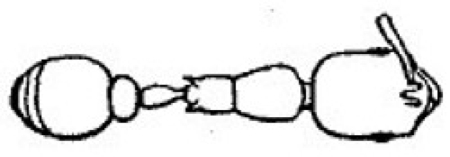 Postpetiole in
dorsal view oval, slightly wider than long (nuda-group) Postpetiole in
dorsal view oval, slightly wider than long (nuda-group) |
2 |
| -- |  Postpetiole
in dorsal view heart-shaped, noticeably wider than long Postpetiole
in dorsal view heart-shaped, noticeably wider than long |
5 |
| 2 | Metanotal groove hardly visible | 3 |
| -- | Metanotal groove well marked | 4 |
| 3 | 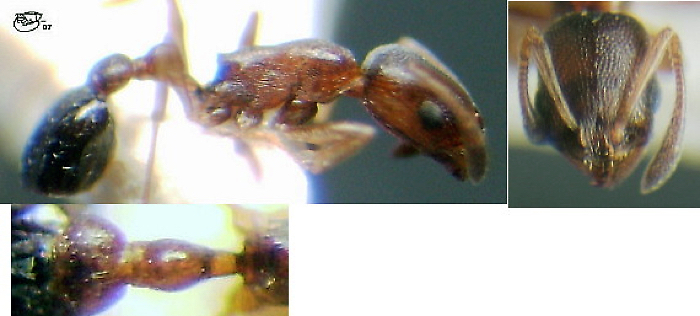 Propodeum with two
small triangular spines, short with a broad base; postpetiole
hexagonal; TL 2.0-2.5 mm; alitrunk rugosity quite distinct giving an
opaque appearance; alitrunk dark red, head and gaster near black Propodeum with two
small triangular spines, short with a broad base; postpetiole
hexagonal; TL 2.0-2.5 mm; alitrunk rugosity quite distinct giving an
opaque appearance; alitrunk dark red, head and gaster near black |
mauritanica |
| -- |  Propodeum with triangular teeth, somewhat raised
and dark; metanotal groove marked; TL 2.2 mm; alitrunk dorsum and
pedicel nodes subtly but densely sculptured, laterally
reticulo-punctate; fuscous, head and alitrunk darker, pedicel paler,
antennae and tarsi ochraceous but antennal club blackish Propodeum with triangular teeth, somewhat raised
and dark; metanotal groove marked; TL 2.2 mm; alitrunk dorsum and
pedicel nodes subtly but densely sculptured, laterally
reticulo-punctate; fuscous, head and alitrunk darker, pedicel paler,
antennae and tarsi ochraceous but antennal club blackish |
probably not found in Egypt - nuda |
| 4 |  Propodeum
varying from merely angular to with acute spines; TL 2.2 mm; wholly yellow-brown, apex of gaster piceous,
head and antennal club brown-piceous Propodeum
varying from merely angular to with acute spines; TL 2.2 mm; wholly yellow-brown, apex of gaster piceous,
head and antennal club brown-piceous |
emeryi |
| . | Postpetiole in dorsal view heart-shaped | . |
| 5 |  Petiole node clearly wider than long and slightly raised
with a flat to concave anterior; second segment of funiculus as wide or
slightly wider than long; wholly piceous; Petiole node clearly wider than long and slightly raised
with a flat to concave anterior; second segment of funiculus as wide or
slightly wider than long; wholly piceous; |
elegans |
| -- | Petiole node as long or longer than wide and distinctly raised; | 6 |
| 6 | 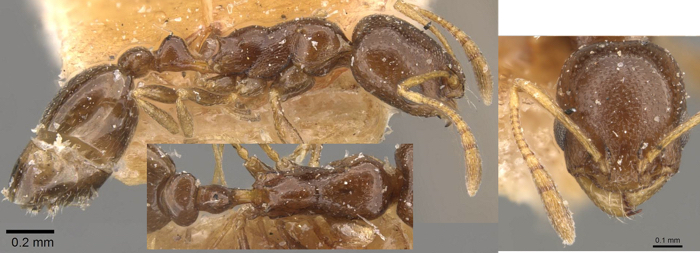 TL 2.0 mm; extensively
yellow-rust; more abundant pubescence than type (elegans) and
much stronger puncturation, especially on the head TL 2.0 mm; extensively
yellow-rust; more abundant pubescence than type (elegans) and
much stronger puncturation, especially on the head |
sahlbergi |
| -- | 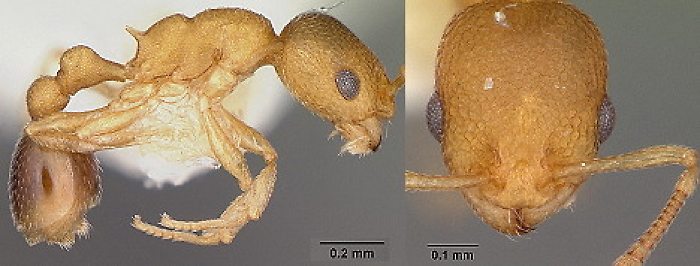 TL 1.7 mm; head mostly
shiny with large spaced out puncturations; metanotal groove very deep
but with no strangulation (waisting); propodeum dorsum flat, spines
short and obtuse; alitrunk irregularly punctate and quite matt;
distinctive lateral widening of mesonotum; gaster and pedicel smooth
and shiny; abundant pale yellow pubescence; pale testaceous yellow,
gaster yellow brown TL 1.7 mm; head mostly
shiny with large spaced out puncturations; metanotal groove very deep
but with no strangulation (waisting); propodeum dorsum flat, spines
short and obtuse; alitrunk irregularly punctate and quite matt;
distinctive lateral widening of mesonotum; gaster and pedicel smooth
and shiny; abundant pale yellow pubescence; pale testaceous yellow,
gaster yellow brown |
wroughtonii |
Seifert Key (2003) - adapted
Note - wroughtonii and sahlbergi are not given as from Egypt and, emeryi ssp chlorotica is regarded as incertae sedis (probably a synonym of wroughtoni or obscurior).
|
|
||
| 1 | Postpetiole with prominent anteroventral corners; seen from a frontal angle the anterior margin is concave (6 above) | 2 |
| -- | Postpetiole without prominent anteroventral corners (5 above) | 3 |
| 2 | 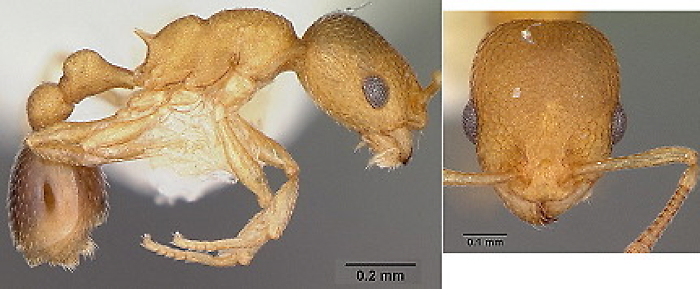 First and following gaster tergites not equally
dark First and following gaster tergites not equally
dark |
cosmopolitan tramp - wroughtonii |
| -- | 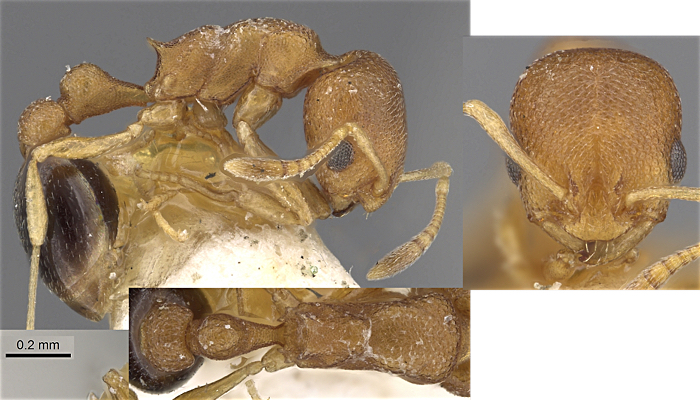 First and following gaster tergites equally dark First and following gaster tergites equally dark |
cosmopolitan tramp - obscurior |
| 3 |  FRS/PPH < 0.722; Small CS 386-457 µm; head
elongated CL/CW 1.19-1.27; postpetiole as high as petiole with
conspicuous ventral bulge; propodeal spines moderately long FRS/PPH < 0.722; Small CS 386-457 µm; head
elongated CL/CW 1.19-1.27; postpetiole as high as petiole with
conspicuous ventral bulge; propodeal spines moderately long |
widespread tramp - emeryi |
| -- |
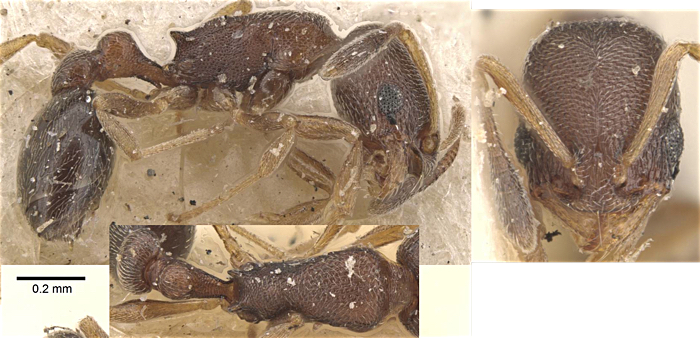 FRS FRS |
widespread tramp - minutior |
| -- | FRS/PPH > 0.722 | 4 |
| 4 | Eyes small (EYE 0.199-0.246); postocular index large; postpetiole narrow | 5 |
| -- | Eyes larger (EYE > 0.224); postpetiole wider | 7 |
| 5 |  Propodeal spines in lateral view with blunt
angles of 95-120°; sides of postpetiole in dorsal view always rounded
convex; promesonotal and anterior propodeal profiles forming shallowly
convex curvatures to give a wide metanotal depression; head and
alitrunk variably yellowish, gaster dark to blackish-brown, larger CS
556-633 µm Propodeal spines in lateral view with blunt
angles of 95-120°; sides of postpetiole in dorsal view always rounded
convex; promesonotal and anterior propodeal profiles forming shallowly
convex curvatures to give a wide metanotal depression; head and
alitrunk variably yellowish, gaster dark to blackish-brown, larger CS
556-633 µm |
C. shuckardi group inc new status fajumensis (ex nuda) inc schatzmayri and nilotica (Sudan) |
| -- | Propodeal spines in lateral view with smaller angles of 60-95°; sides of postpetiole in dorsal view more angular; promesonotal and anterior propodeal profiles not forming shallowly convex curvatures, so metanotal depression weak or absent | C. nuda group inc mauritanica - 6 |
| 6 |  Propodeal dorsum not sloping down in posterior
half; propodeal spines distinct (not very blunt); body slender; head
longer; postpetiole with angualte-convex sides in dorsal view Propodeal dorsum not sloping down in posterior
half; propodeal spines distinct (not very blunt); body slender; head
longer; postpetiole with angualte-convex sides in dorsal view |
mauritanica |
| -- | Propodeal dorsum sloping down in posterior half; propodeal spines reduced to rectangular or obtuse corners; generally shorter and more thickset; postpetiole with rounded sides in dorsal view | mauritanica morph B (Sinai) |
| 7 |  Eyes large (EYE 0.249-0.283); postocular index
small; postpetiole rather narrow; anterior postpetiolar sternite
completely flat, in profile changes into the helcium without a distinct
angle Eyes large (EYE 0.249-0.283); postocular index
small; postpetiole rather narrow; anterior postpetiolar sternite
completely flat, in profile changes into the helcium without a distinct
angle |
C. batesii group, inc. nigra - revised species - nigra j syn torretassoi (Wadi Halfa specimens) |
| -- | Eyes medium (EYE 0.224-0.262); postocular index larger; postpetiole wider; anterior postpetiolar sternite medially bulged, in profile changes into the helcium with a distinct angle | C. bulgarica group inc israelica & sahlbergi - 8 |
| 8 | 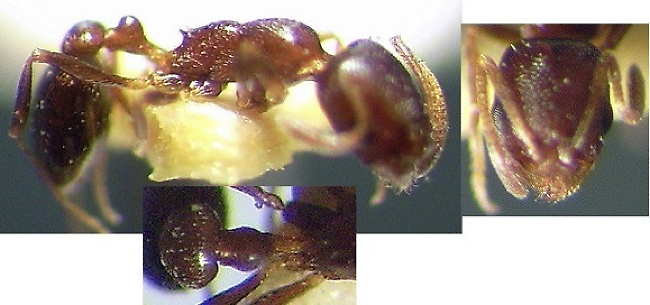 Petiole relatively narrow, with a steeper
anterior profile, concolourous medium brown with yellowish tinge Petiole relatively narrow, with a steeper
anterior profile, concolourous medium brown with yellowish tinge |
new species - Sinai & Israel - israelica (originally as syntypes of torretassoi; earlier reported as sahlbergi by me, and as wroughtoni by Mohamed et al) |
| -- |  Petiole wider; concolourous dark brown Petiole wider; concolourous dark brown |
Tunisia (no Egypt reports) then Near East - sahlbergi |
|
©2006, 2012, 2019 - Brian Taylor
CBiol
FRSB FRES 11, Grazingfield, Wilford, Nottingham, NG11 7FN, U.K. |
href="cardiocondyla.htm"